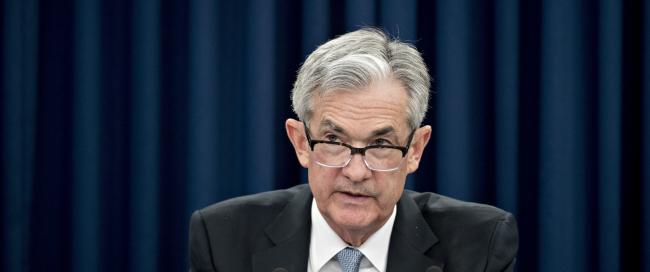 © Bloomberg. Jerome Powell, chairman of the U.S. Federal Reserve, speaks during a news conference following a Federal Open Market Committee (FOMC) meeting in Washington, D.C., U.S., on Wednesday, March 21, 2018. Federal Reserve officials, meeting for the first time under Powell, raised the benchmark lending rate a quarter-point and forecast a steeper path of hikes in 2019 and 2020, citing an improving economic outlook. Policy makers continued to project a total of three increases this year.
© Bloomberg. Jerome Powell, chairman of the U.S. Federal Reserve, speaks during a news conference following a Federal Open Market Committee (FOMC) meeting in Washington, D.C., U.S., on Wednesday, March 21, 2018. Federal Reserve officials, meeting for the first time under Powell, raised the benchmark lending rate a quarter-point and forecast a steeper path of hikes in 2019 and 2020, citing an improving economic outlook. Policy makers continued to project a total of three increases this year.(Bloomberg Gadfly) — Federal Reserve Chairman Jerome Powell, as much as any other individual, now has the keys to the U.S. economy. Investors must now evaluate how well he can drive it.
His first move appeared to be a break from the Fed’s go-slow approach, though it may be less of a break than it appears. On Wednesday, the Fed announced, as expected, that it was raising its key short-term target interest rate a quarter of a percentage point to 1.50 percent to 1.75 percent. It was the first hike this year and only the sixth since the financial crisis. It was also the first under Powell since he stepped up to the top job last month.
More important, the Fed, while sticking to its projections for three rate increases this year, said in its March statement that the economy’s outlook had strengthened and that the path of interest rates would most likely be steeper than most have been expecting in 2019 and 2020. Investors had been on the lookout for that more aggressive stance and gave it mixed reviews. The market, which was up before the Fed announcement, pulled back after the statement came out.
In reality, what Powell did at his first meeting wasn’t critical, at least as far as the immediate economy is concerned. Indeed, most prognosticators don’t expect a recession anytime soon. What’s more, the Fed has routinely overpredicted the path of the economy during the recovery and now long but slow expansion. And it could be continuing on that path.
A big reason for the overshoot has been an overestimation of the power of interest rates. Over the past decade low rates have not provided the economic lift they once did. That means the Fed could have continued to keep rates low. At the same time, the case for higher rates is pretty strong as well. The economy and the market continue to hum along. Neither Washington mayhem nor tariffs seem to be able to blow the market or the economy off course. The tax cut most likely ensured that growth remains at least steady this year. So the decision on the pace of rate increases was essentially a toss-up.
That being said, surprises matter, and not because they indicate the future path of interest rates but because of what they say about the Fed. The most dangerous part of Powell’s strong indication that the Fed will move faster is that it indicates he thinks the Fed made a policy error in the past by keeping rates too low for too long. Powell has some leeway to make changes as a new head of the Fed, and the more aggressive tone works for now because it can always be modulated later, but he will quickly find that the Fed needs all the confidence and credibility from the market that it can get. Powell may be able to surprise the market a bit today and get away with it, but that won’t be the case for long.
Powell can wring the car out a bit without too much fuss now, but he will have to be careful while charting his own route.
This column does not necessarily reflect the opinion of Bloomberg LP and its owners.
Stephen Gandel is a Bloomberg Gadfly columnist covering equity markets. He was previously a deputy digital editor for Fortune and an economics blogger at Time. He has also covered finance and the housing market.
Fusion Media or anyone involved with Fusion Media will not accept any liability for loss or damage as a result of reliance on the information including data, quotes, charts and buy/sell signals contained within this website. Please be fully informed regarding the risks and costs associated with trading the financial markets, it is one of the riskiest investment forms possible.
Source: Investing.com


























